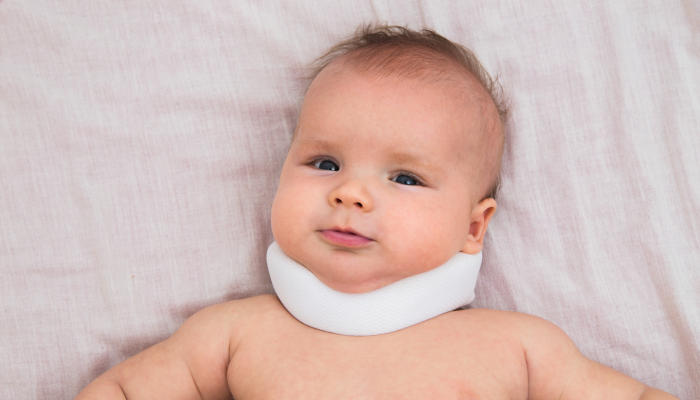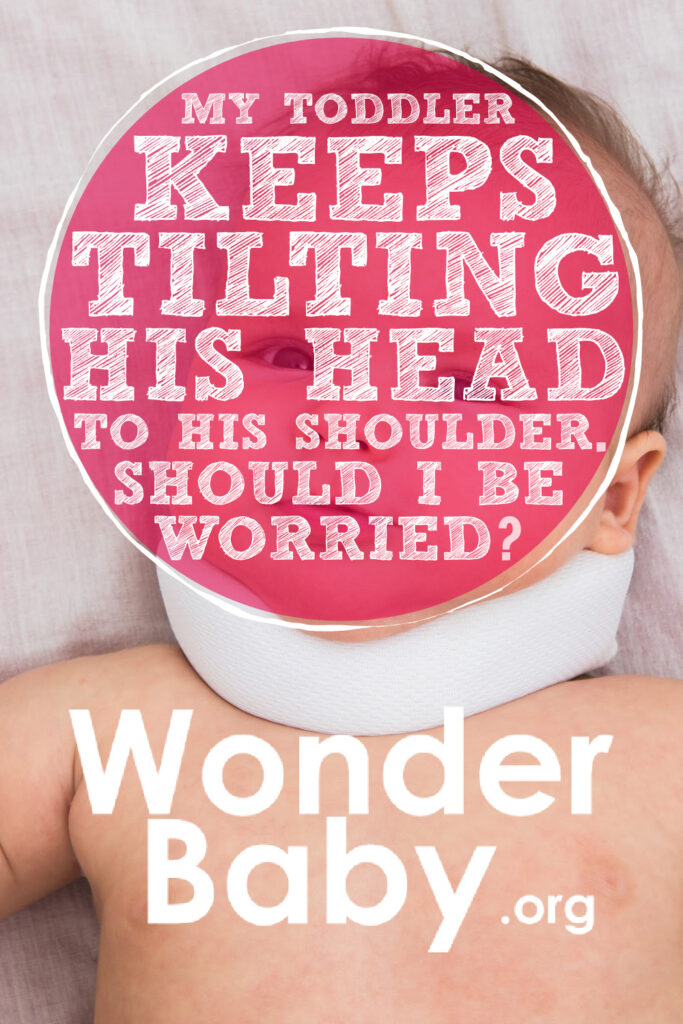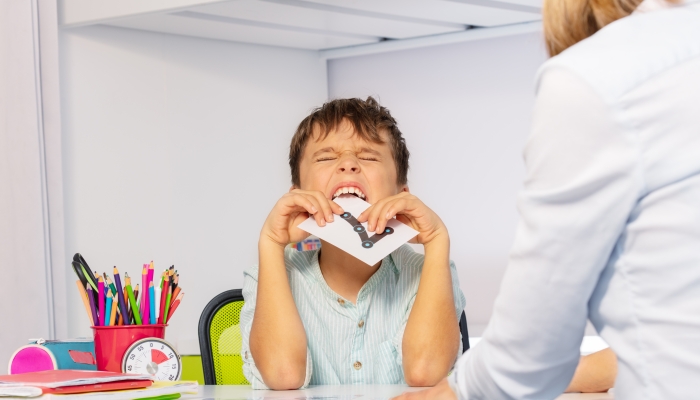My Toddler Keeps Tilting His Head to His Shoulder. Should I Be Worried?

- Toddlers may tilt their heads to their shoulders because of tight muscles or problems with their bone structure.
- If your toddler seems to be in pain or unable to stop tilting their head to their shoulder, seek medical attention.
- Torticollis can usually be corrected with physical therapy. However, severe torticollis may require surgery.
- Other causes of head tilting include ear infections, vision problems, and neurological conditions.
Babies and children are always testing new ways to move their bodies and explore the world around them. It can sometimes be a challenge for parents to figure out if their child is testing the limits of their muscles and environment, or if their behavior indicates a more serious problem. Head tilting is one of those behaviors that parents may worry about.
There are several different reasons that your toddler keeps tilting head to shoulder. Some are not a problem, and some may require an intervention.
Common Causes of Head Tilting in Toddlers

If your child occasionally tilts their head to the side or lays in a strange position, the cause is probably benign. Babies and children who sometimes tilt their heads to one side may be exhibiting copying behavior, looking for comfort, or exploring new perspectives.
Alternatively, if your child seems to have a consistent head tilt, hold their head in an abnormal position, or struggle with neck pain, you may need to investigate some potential medical causes.
Potential medical causes for head tilting in toddlers include:
- Muscular torticollis: According to the American Academy of Pediatrics, torticollis11. Head Tilt (Torticollis). HealthyChildren.org. 2020. https://www.healthychildren.org/English/health-issues/conditions/Cleft-Craniofacial/Pages/Head-Tilt.aspx is the most common cause of head tilt in babies and young children. There are two types of torticollis: Acquired torticollis is more common in older children and can be caused by an upper respiratory virus, a throat infection, or injury to the muscle or spine. Congenital muscular torticollis is more common in younger babies and can be caused by a baby’s position in the womb or traumatic birth.
- Ear infections: Ear infections can also cause a child’s head to tilt if they are trying to position their unaffected ear to hear more clearly or trying to ease the discomfort of the ear infection. Children with frequent ear infections are more likely to develop tight neck muscles and need an intervention to loosen the muscles on one side.
- Hearing loss. Similarly to having an ear infection, a child with hearing loss on one side may tilt their head in one direction in an attempt to hear things more clearly.
- Acid reflux. Experts at the American Family Physician22. Ahuja, V., Yencha, M. W., & Lassen, L. F.. Head and neck manifestations of gastroesophageal reflux disease. American Family Physician. 1999;60(3), 873–886. https://pubmed.ncbi.nlm.nih.gov/10498113 journal warn that severe reflux may cause a constant sore throat, headaches, and even vocal cord problems. If left untreated, a child with severe acid reflux may develop acquired torticollis.
- Vision problems. If you notice your child holds their head tilted when looking at objects that are nearer or further away, they may be experiencing vision problems. The American Academy of Ophthalmology33. Repka, M. X.. Why do I tilt my head to see clearer?. American Academy of Ophthalmology. 2017. https://www.aao.org/eye-health/ask-ophthalmologist-q/why-do-i-tilt-my-head-to-see-clearer explains that head tilting may improve vision by helping the eyes work together.
- Neurological conditions. While they are rare, some serious neurological conditions can cause head tilting in children. A brain tumor, seizure disorder, or musculoskeletal condition can all cause your baby’s head to tilt.
Diagnosis, Treatment, and Management
Parents who are worried about their child’s tilted head can speak to their doctor about seeking a diagnosis and medical care. Fortunately, most babies’ head control and position will improve with physical therapy or treatment of the underlying cause.

Diagnosis
The first step in treating any health problem is to confirm a diagnosis. Your pediatrician can perform several tests to determine the cause of your child’s head tilt. These include:
- Assessing the neck muscles for tightness.
- Obtaining an x-ray of the upper spine.
- Performing a hearing test.
- Performing a vision test.
- Looking for any small lump on one side of the head or neck.
- Completing an ear, nose, and throat evaluation.
- Testing for any upper respiratory or ear infections.
Since most head positioning problems are caused by torticollis, your pediatrician will most likely check your child’s neck for tightness first. If the sternocleidomastoid muscle is not the cause of your baby’s stiff neck, your pediatrician will start looking into more serious causes.
Treatment and Management
After your pediatrician helps determine the cause of your child’s head tilt or stiff neck, you can develop a treatment plan for your child.
Most children are eventually able to hold their heads in a normal position after receiving treatment. Treatment options may include:
- Physical therapy exercises for muscular torticollis: Physical therapy involves stretching your child’s head in the opposite direction of their head tilt. This should be done carefully and only with the guidance of a licensed physical therapist. In addition, parents can help their children by placing the baby’s head in a neutral or normal position for sleep. Some children may need a special brace in addition to physical therapy to position the neck muscles and correct torticollis.
- Medical treatment for ear infections: For children with ear infections, a doctor may prescribe either oral antibiotics or ear drops. If your baby has frequent ear infections, they may need to have tubes surgically placed in the ear canal.
- Addressing vision problems: Most children have their vision tested at their routine annual check-ups. If a doctor suspects an issue, they may refer you to a specialist for a more thorough vision test. Children with vision problems may need glasses, an eye patch, or surgery, depending on the severity of the issues.
- Interventions for neurological concerns: Although they are rare, some neurological conditions may cause head tilting in babies and children. Depending on the exact etiology, neurological problems may require more frequent physical therapy, medications, or surgery. Parents of children with neurological problems should work closely with their care team to create a good treatment plan.
Home Care and Exercises

After working with their pediatrician, parents of children with torticollis are often able to help their children with different stretches and exercises at home. Some children may need to wear neck braces or splints to correct their head position.
FAQs
What are the effects of untreated head tilting in toddlers?
If left untreated, prolonged head tilting can affect the muscle, skull, and spine permanently. Untreated torticollis can also lead to a deformational plagiocephaly44. Deformational Plagiocephaly. Johns Hopkins Medicine. https://www.hopkinsmedicine.org/health/conditions-and-diseases/deformational-plagiocephaly or a flattened skull. Children who receive intervention at the first sign of torticollis or head tilting can usually avoid a flattened skull and permanent spinal issues.
If torticollis or deformational plagiocephaly are severe, they may require surgical treatment.
References
- Head Tilt (Torticollis). HealthyChildren.org. (2020, August 21). https://www.healthychildren.org/English/health-issues/conditions/Cleft-Craniofacial/Pages/Head-Tilt.aspx
- Ahuja, V., Yencha, M. W., & Lassen, L. F. (1999). Head and neck manifestations of gastroesophageal reflux disease. American Family Physician, 60(3), 873–886. https://pubmed.ncbi.nlm.nih.gov/10498113
- Repka, M. X. (2017, December 28). Why do I tilt my head to see clearer? American Academy of Ophthalmology. https://www.aao.org/eye-health/ask-ophthalmologist-q/why-do-i-tilt-my-head-to-see-clearer
- Deformational Plagiocephaly. Johns Hopkins Medicine. (n.d.). https://www.hopkinsmedicine.org/health/conditions-and-diseases/deformational-plagiocephaly

The information WonderBaby provides is not intended to be, and does not constitute, medical or other health advice or diagnosis and should not be used as such. Always consult with a qualified medical professional about your specific circumstances.
Related Posts

Behavior
Understanding Intermittent Explosive Disorder in Children
Are you worried about your child’s unexpected aggression and explosive behaviors? Learn how to support a child with intermittent explosive disorder.

Behavior
5 Emotional Regulation Activities for Kids
Want to teach your child how to regulate emotions? Here are emotional regulation activities for kids that can help!

Behavior, Special Needs
5 Tips for Dining Out with Children Who Have Sensory Sensitivities
Worried about dining out with sensory sensitivities? Try these tips for less stress and more fun the next time you take your family out to eat.